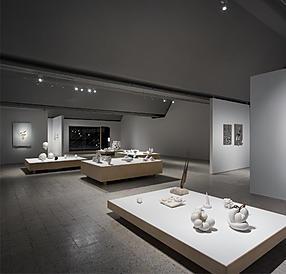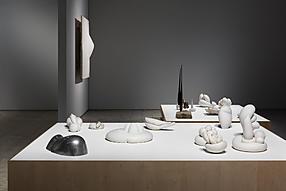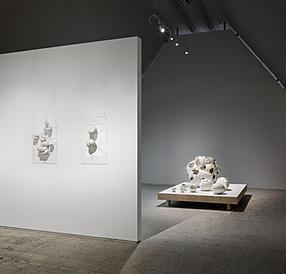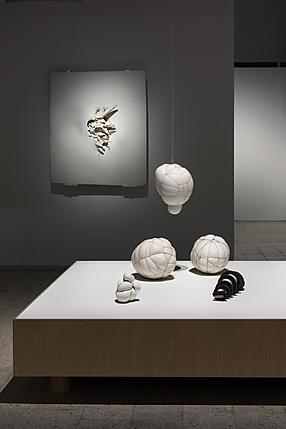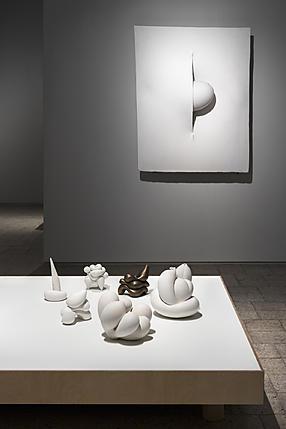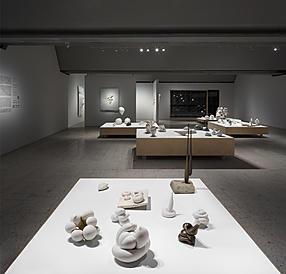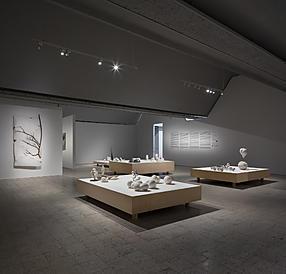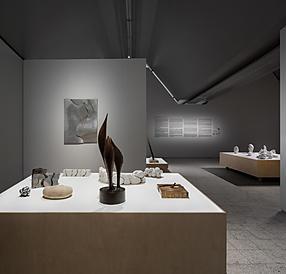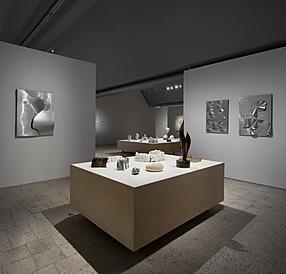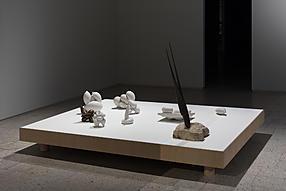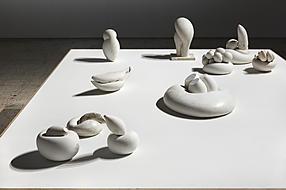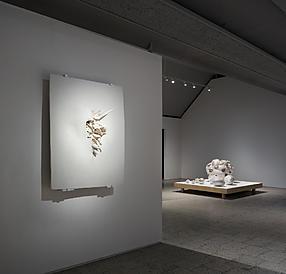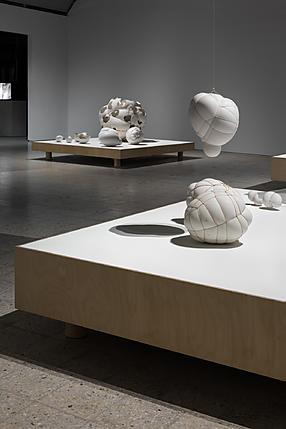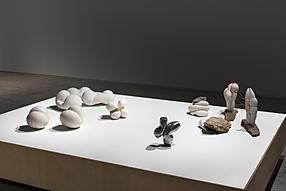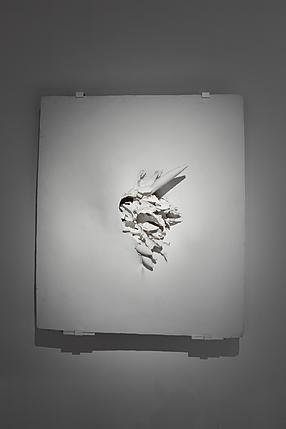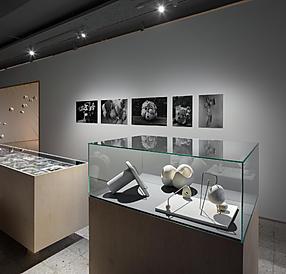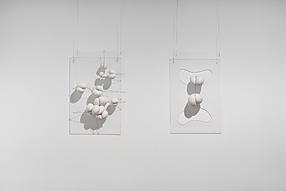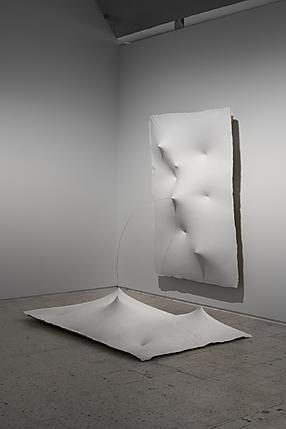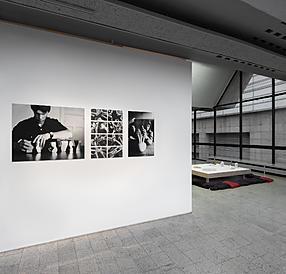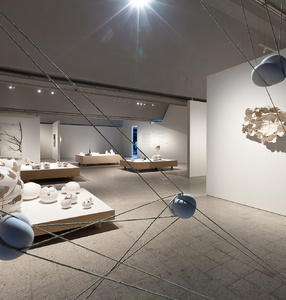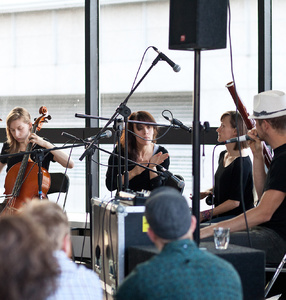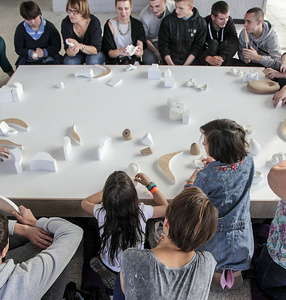Maria Bartuszová. Provisional forms
Exhibition's documentation
Documentation of the "Maria Bartuszova. Provisional forms" exhibition (2014-09-25 to 2015-01-04 at the Museum of Modern Art in Warsaw).
The phenomenon of the discovery of female artists whose work remained below the mainstream radar of their time has been changing the scenery of the history of the art of the second half of the 20th century. These artists not only experimented formally and embarked intuitively on new themes but, rejected by mainstream modernist trends, they remained working in isolation, or at least marginalised. And yet, they were pioneers who invented the language of contemporary expression. A point in case is the art of Maria Bartuszová.
Maria Bartuszová (1936–1996) has been, so far, a little known Slovak sculptor, revealed to the general public in 2007 during Documenta 12 in Kassel – since then, her works have begun to appear occasionally in international exhibitions and some of them have found their way into prestigious collections of contemporary art. Bartuszová’s art has not, however, yet achieved true recognition: her works have been exhibited individually, without a broader context and with no reference to the broader dynamics of her work.
The exhibition „Maria Bartuszová: Provisional Forms” is an attempt to write a history that has never been written. Neither has it ever been conveyed in any coherent way, whereas this work is built on a dense mesh of incredibly potent and dynamic references, reversions and unexpected new departures – a record of hesitation and the search for a new language.
Originally from Prague, after graduating in 1961, Bartuszová, together with her husband, also an artist, moved to Košice, a backwater far away from the world of art. Innumerable group exhibitions, casual membership of the-then fashionable ‘Concretists’ Club’ and a few public projects were the sum total of her official artistic life. This was compounded by the limitations imposed by her life in a totalitarian system, financial problems and, in due course, the bringing up of children single-handedly. Under such circumstances, artistic experiments would seem quite a challenge. And yet, against all odds, Bartuszová’s works exude power and the will to overcome: her oeuvre consists of some 400 works; a lasting (in spite of their extreme fragility) testimony to her extraordinary struggles and formal experiments.
The majority of the artist’s works are made in plaster – a material by nature preparatory and impermanent. For this reason alone, despite their perfect shape, her sculptures are, as it were by design, tentative, unfinished and transitory. They connote mobility and hesitation – a hypothesis rather than a conclusion. On the occasions when Bartuszová succumbed to the temptations of using bronze or aluminium, she would immediately undermine, through either form or subject matter, their material weight: softening the material, putting it in motion, altering its proportions and mocking gravity. Her material of choice, however, appears to have been plaster (which was cheap) and it was plaster that was to become not only the material of her art but also – through its inherent impermanence and transitory nature – its core message.
The artist’s early works were inspired by natural processes. These sculptures don’t appear to have been created; rather, they emerge and take shape as if a result of the pressure of gravity, the weight of water or wind or due to having emerged from under melting snow. These works appear not to have been created for art galleries but, instead, in order to become part of the landscape or a natural process; they look as if their essence were elsewhere, without rather than within. This is distillation rather than creation, reaction rather than appropriate action, process rather than the target object – and, at the same time, persistence, tension and a kind of conviction that, however ‘fragile’ the hypothesis in hand, it merits pursuing it further.
Such an experimental approach – to oneself as an artist (testing whether one is a creator or re-creator), to materials (the manner of their subjectification), and also to the content (never stable, always in motion, in a transitory state: falling, melting, budding or eventually decaying) – intensifies further when we observe closely the means by which the artist multiplies her remaining forms. To employ multiplication of form is not only the way to invest it with a ‘sign of life’ – as an organic flow of one form into another – but also a game, playing „with” and „through” sculpture.
From the late 1960s, Bartuszová produced works that were a kind of assembly kit: you could take them apart as you pleased, only to re-assemble them again, more or less intuitively. It is worthwhile at this point to recall one of the artist’s most unusual ventures: in 1976 and 1983, together with the art historian Gabriel Kladek, she ran workshops for blind and visually-impaired children. She created sculptures that enabled those unable to see to get to know various forms and textures, to differentiate between geometric and organic forms, to recognise their emotional significance and to develop their aesthetic imagination. Such trespass on the neutral territory of art, ‘alternative’ usage and the emphasis on the haptic characteristics of sculpture manifest Maria Bartuszová’s strikingly avant-garde approach to her artistic tasks.
From the 1980s, her work was dominated by pure, ovoid forms, hollowed eggs and shells, whose perfect shapes were subjected to deformation – crushing, squeezing, breaking, tying and considerable squashing. The most appealing are the groups of oval forms constrained with string, sometimes additionally weighted with small stones, in which the fragile plaster matter, squashed and limited by the external constraints seems to sizzle with life. Through its taut strings, these forms exude the ebullient energy of growth.
These works seem to be the watershed in Bartuszová’s art, because not only do they make her approach to the pulsating natural forms more complex but they also validate the choice of plaster as material. The earlier distillation of forms ceases to be a unilateral, kindly act of the sensitive artist bestowing his (or her!) attention and begins to function as a multi-layered act of oppression. For one thing, this is an act of cornering these forms, snatching them away from nature, and at the same time it is an act of self-defence and presenting opposition on the part of the forms themselves. Here, pulsation acquires a decidedly new meaning, and from now on, each of the sculptures created by Bartuszová will carry within it the force of a two-vector movement: centripetal and centrifugal.
The material aspect of working with plaster further, albeit in a very intimate way, develops the tension (in Bartuszová’s art every act of giving up, rather than retreating, results as reinforcement of the effect.). The white surface of plaster – that experimental and temporary material – is a surface created by the physical presence of hands – squeezing, shaping, smoothing. The marks left by the hands and their imprints are materially present in the plaster and it is they that have defined it. At the same time, these marks and imprints rest on the surface and go no further. The surface is their limit, and the resultant object appears somewhere along the (shifting) division line between pressure and resistance.
This gesture of touching and imprinting transforms (achronologically) into gestures even more radical than squeezing: those of cutting, stabbing, piercing or tearing. And so, even though Maria Bartuszová created exclusively abstract forms – unusually sparse or even minimalistic in expression – her art sizzles not only with violence but also eroticism, the intuition of damnation and the hope of memory, a deep reflection on the origins of life.
In the final phase of her creativity (thus in the works produced since the mid-1980s) Maria Bartuszová began to employ a singular method of obtaining plaster casts by means of her signature technique, called ‘pneumatic shaping’. The cast was produced with elastic rubber balloons over which she poured concrete. The touched swaps places with the person touching, and the balloons, weighted with the quickly crumbling mass, burst under its pressure. The resulting objects – one can hardly refer to their having been ‘created’ – are the negatives of the presence of the destroyed positives. Their form brushes against their own impossibility: they are infinitely crumbly and thin as well as very sensitive; due to their material impermanence they are borderline ephemeral sculptures.
These works, that look like abandoned cocoons, traces of past presence, now-defunct shells, began from the late 1980s to fill up and overgrow Bartuszová’s studio and, later, also her garden. Sterile nests, petrified forms flooded and stifled the growing branches; they no longer had anything in common with their earlier watching and imitating nature. This was an invasion of nature, a fight with nature. At the same time, the material employed continued to be plaster; exposed to the wind and rain, it would last only a brief while.
The exhibition „Maria Bartuszová: Provisional Forms”, planned at the Museum of Modern Art, consists of an extensive selection of sculptures – some 80 objects are presented in an area of 300 m2 – which the artist created between the early 1960s and the end of the 1980s. The exhibition is not, however, organised along purely chronological lines. On the contrary, it sets out to capture the tensions in the artist’s works, the relationships between them – whether causative or of development and inspiration, but also those of negation, excess and abandonment – her need for formal experimentation, the effort of seeking a new language of expression and innovative uses of material. Working with plaster – a material which, from a sculptor’s point of view, is both primitive and common, Bartuszová experimented with it and did not hesitate to treat tradition, accepted norms and learnt techniques as merely transitory and provisional.
Rather than thematising the collection of objects, the exhibition focuses on the moment at which the artist – driven by an inner impulse – invents a new language. Although, objectively, almost everything combined to subdue Maria Bartuszová – her isolation and creative estrangement, living in the shadow of her husband, a ‘great’ artist, the lack of recognition in the local artistic community and her being repeatedly turned down for exhibitions – the exhibition will demonstrate the effort of pressure against resistance and resistance against pressure – the artist’s indomitable creative energy. The fact that her art happens in parallel with the paradigm shift of the time that transformed the status quo makes this art – however peripheral, isolated and indeed forgotten – epitomise the spirit of the time and the nascent new idiom of contemporary art.
An important element of the exhibition is the extraordinarily atmospheric, archival material, which will reveal the artist’s creative process, including photographs of the works created in nature and ‘for’ nature as well as works that, through their inherent fragility, have not withstood the test of time.

